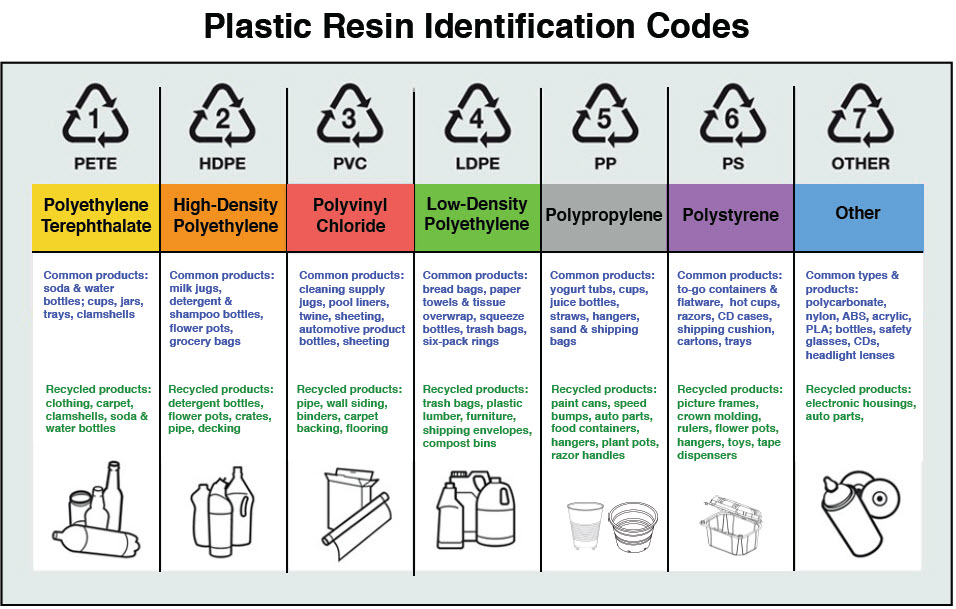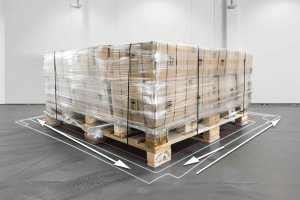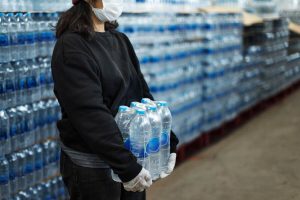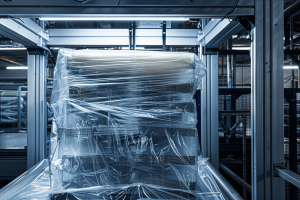
Plastic Numbers: What Do They Mean?
Plastic packaging containers have a number (1 to 7) on the bottom or side that gives the identification code of the resin.
This code is also known as the recycling number. The purpose of this resin identification code is to give a guide to consumers who want to recycle plastic containers.
Check out a list of the most common plastics used in food packaging. All of these plastics have been approved by the FDA to be in contact with food.
PETE or PET (Recycling number 1 / Resin ID Code 1)
Polyethylene terephthalate also known as PETE or PET is a thin plastic that is made to be semi-rigid or rigid to be more impact resistant. This type of plastic is great to protect food or liquids inside the packaging.
PET uses:
- Soft and sport drinks
- Single-serve water
- Ketchup
- Salad dressing
- Vegetable oil bottles
- Peanut butter containers
HDPE (Recycling number 2 / Resin ID Code 2)
High-density polyethylene, also known as HDPE is a hard, opaque plastic that is thin but at the same time strong. This plastic can be recycled.
HDPE uses:
- Juice and milk jugs
- Squeeze butter
- Vinegar bottles
- Chocolate syrup containers
- Grocery bags
PVC (Recycling number 3 / Resin ID Code 3)
Polyvinyl chloride, also known as PVC is a common type of plastic that is biologically and chemically resistant. With these two characteristics, PVC containers are a great option to maintain the integrity of the products inside. PVC plastic is recycled.
PVC uses:
- Tamper-resistant over-the-counter medication
- Stretch film
- Vinyl is also used in blister packaging
PVC Food Wrap
PVC food wrap is the thin clear plastic that is used to keep your food safe for storage and transportation. This type of plastic is commonly used for catering, to wrap food such as fruits, vegetables, sandwiches, cheese, and cooked meats.
LDPE (Recycling number 4 / Resin ID Code 4)
Low-density polyethylene (LDPE) is thinner and it is also flexible in high heat temperatures. You should check with your recycling centre if LDPE can be recycled in your area.
LDPE is tough and flexible so it is mostly used in stretch film applications.
LDPE uses:
- Coffee can lids
- Bread bags
- Six-pack soda can rings
- Fruit and vegetable bags used in grocery stores.
PP (Recycling number 5 / Resin ID Code 5)
Polypropylene, also known as PP can be made translucent and opaque. As it can endure high temperatures, it can be used for food packaging products that are used in microwaves or cleaned in dishwashers. PP can be recycled.
PP uses:
- Yogurt containers
- Sour cream containers
- Prescription drug bottles
PS (Recycling number 6 / Resin ID Code 6)
Polystyrene, also known as PS is a hard plastic that has no colour and not much flexibility. This type of plastic can be made into foam or cast into molds. It can also be recycled.
PS uses:
- Plastic cups
- Deli and bakery trays
- Fast food containers and lids
- Hot cups
- Egg cartons
- Plastic cutlery
Other or O (Recycling number 7 / Resin ID Code 7)
When you see in a food container ‘other or a #7 symbol’, it means that it is made with another type of plastic resin different from the other six types listed above.
For example, food packaging can be made with polycarbonate or bioplastic polylactide or with more than one plastic resin.
This type of plastic can be recycled.
Uses:
- Water cooler five-gallon jugs
- Some citrus juice bottles
- Ketchup bottles
- Cups
- Coffee lids
- Clamshell containers
In a Nutshell
Plastic food packaging provides protection, tampering resistance, and it is great for storage and transportation.
They have features that add convenience for stacking, display, use, reuse and recycle.
Of course, one of the best ways to protect the environment is by recycling.
Save Earth, Save Life!





